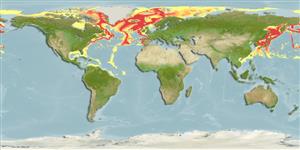Bivalvia |
Not assigned |
Cuspidariidae
Environment: milieu / climate zone / गहराई सीमा / distribution range
पारिस्थितिकी
; गहराई सीमा 117 - 3292 m (संदर्भ 83435). Polar; 80°N - 18°N, 175°W - 155°E
Atlantic Ocean, Northern Pacific and the Arctic.
Length at first maturity / आकार / Weight / Age
परिपक्व अवधि: Lm ? range ? - ? cm
Maximum depth from Ref. 104365. Deep-sea (Ref. 104365).
Life cycle and mating behavior
परिपक्व अवधि | पुनरुत्पत्ति | मछलीऔ का अंडे देना | Eggs | Fecundity | Larvae
Members of the class Bivalvia are mostly gonochoric, some are protandric hermaphrodites. Life cycle: Embryos develop into free-swimming trocophore larvae, succeeded by the bivalve veliger, resembling a miniature clam.
Cusson, M., P. Archambault and A. Aitken 2007 Biodiversity of benthic assemblages on the Arctic continental shelf: historical data form Canada. Mar. Ecol. Prog. Ser. 331:291-304. (संदर्भ 3448)
IUCN Red List Status
(संदर्भ 130435: Version 2025-1)
CITES status (संदर्भ 108899)
Not Evaluated
CMS (संदर्भ 116361)
Not Evaluated
Threat to humans
Human uses
| FishSource |
साधन
अधिक जानकारी
Trophic EcologyFood items (preys)
संघटक आहार
आहार खपत
परभक्षी
Population dynamicsबाढ़
Max. ages / sizes
Length-weight rel.
Length-length rel.
Length-frequencies
Mass conversion
बहुतायत
Life cycleपुनरुत्पत्तिपरिपक्व अवधिFecundityमछलीऔ का अंडे देनाEggsEgg developmentLarvae PhysiologyOxygen consumption
Human RelatedStamps, coins, misc.
इंटरनेट स्रोत
Estimates based on models
Preferred temperature
(Ref.
115969): 0.1 - 4.2, mean 1.7 (based on 326 cells).
Price category
Unknown.
